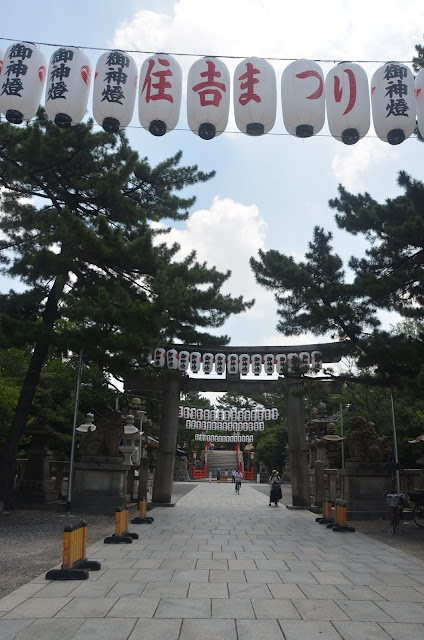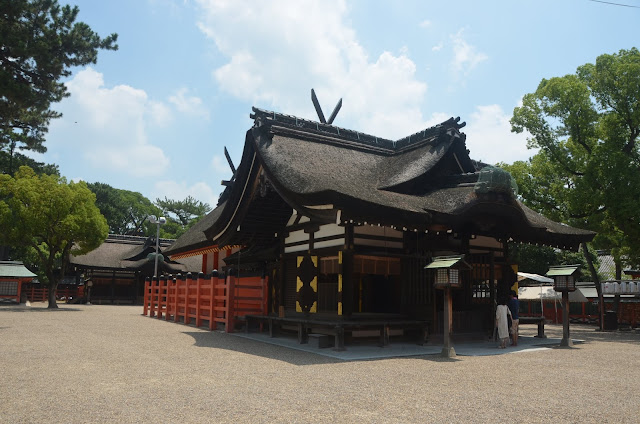Shitennoji (四天王寺) is a large temple with a big decorated pagoda and a Buddhist temple. It has a large pond with an incredible number of turtles in it. The temple grounds are fairly stark and empty with the majority of area being open bare dirt.
 |
四天王寺 本坊
|
 |
| Shitennoji (四天王寺) |
 |
| Shitennoji (四天王寺) |
 |
| Shitennoji (四天王寺) |
 |
| View of Tsutenkaku Tower from Kyu-Kurodahan Kurayashiki Nagayamon, Osaka |
 |
| Kyu-Kurodahan Kurayashiki Nagayamon, Osaka |
 |
| Kyu-Kurodahan Kurayashiki Nagayamon, Osaka |
 |
| Kyu-Kurodahan Kurayashiki Nagayamon, Osaka |
 |
| Isshinji temple (一心寺) |
 |
| Pagoda in the Tenoji area |
Shinsekai (新世界本通商店街) with a small shrine contrasting against the buildings and Tsutenkaku Tower. Shinsekai was an older district near the slum area that was abandoned after the war and revitalized in the industrial exposition, which led it to become a tourist attraction.
 |
| Shinsekai (新世界本通商店街) |
 |
| Shinsekai (新世界本通商店街) |
 |
| Shinsekai (新世界本通商店街) |
 |
| Shinsekai (新世界本通商店街) |
 |
| Shinsekai (新世界本通商店街) at night |
Sumiyoshi Taisha (摂津国一宮 住吉大社) is a lovely temple with a pond and idyllic bridge. The temple grounds are a lot nicer than Shitennoji with trees and arches everywhere and a lot of small shrines. The decorations for summer festivals were starting to be set up so it was decorated with lanterns and flags.
Foxes are regarded as messengers for Inari a shinto spirit. There are many statues and images of foxes frequently with bibs around Japanese temples.
A Guzei, or Red Bridge, is a part of Japanese gardens and temples. Both the bridge itself and the red color of a Guzei have
symbolism. Bridges stand for the crossing from the physical world into
the realm of the spirit, leaving behind profane and confused worldliness
as we are cleansed into a state of purity, wisdom and sacred nature. The color also represents the sacred, as well as wisdom and
transformation. It is entwined with Zen concepts of preserving the life
force, rejecting the delusion of attachment to physical things and
attaining true discernment. Thus these Red Bridges deliver a double dose
of positive growth and spiritual change. They are often described as
representing the path to salvation.
The park near Sumiyoshitaisha Station (住吉大社駅) actually had a fair number of birds even for a fairly open city park. There were herons, egrets, starlings and sparrows around the many ponds and small streams.
It was a lovely spot to relax in the shade by the water and have a convenience store lunch. There also appeared to be a pokemon go spot in the middle of the park where many people on bikes were standing on their phones.
Osaka Castle (大阪城) and the surrounding park was almost deafening with cicadas. The castle is surrounded by two sets of large moats with a large main gate. From the gate you can just see the castle.
The Hōkoku Shrine (豊國神社) is a fairly large shrine just outside of the castle.
Osaka Castle is quite decorated with gorgeous green,black and gold. The small pond at the top floor is one of the few quiet places you can get a photo without other people in it.
The view from the castle shows the contrast between the park and city behind it. The museum is very modern on the inside and you can walk up a lot faster than if you wait to take the elevator.
The view from the other side of the canal gives a lovely landscape of the bridges and the tour boats going in front of the castle.
Kita is a fairly large district with bars, and an arcade/shopping district. Small izakayas can be found on many of the side streets to the large covered shopping street. The food is very good and prices are a bit cheaper than in Shinsekai, but that might just be the place we went to. Streets were lively but not crowded and it was much less touristy, without any gaudy decorations (giant crabs and puffer fish, etc).
 |
| Sumiyoshi Taisha (摂津国一宮 住吉大社) |
 |
| Sumiyoshi Taisha (摂津国一宮 住吉大社) |
 |
| Sumiyoshi Taisha (摂津国一宮 住吉大社) |
 |
| Sumiyoshi Taisha (摂津国一宮 住吉大社) |
 |
| Sumiyoshi Taisha (摂津国一宮 住吉大社) |
 |
| Sumiyoshi Taisha (摂津国一宮 住吉大社) |
 |
| Sumiyoshi Taisha (摂津国一宮 住吉大社) |
 |
| Sumiyoshi Taisha (摂津国一宮 住吉大社) |
 |
| Sumiyoshi Taisha (摂津国一宮 住吉大社) |
 |
| park near Sumiyoshitaisha Station (住吉大社駅) |
 |
| Gray Heron |
 |
| Little Heron |
 |
| Little Heron |
 |
| park near Sumiyoshitaisha Station (住吉大社駅) |
 |
| Osaka Castle (大阪城) |
 |
| Osaka Castle (大阪城) |
 |
| Hōkoku Shrine (豊國神社) |
 |
| Osaka Castle (大阪城) |
 |
| Osaka Castle (大阪城) |
 |
| Osaka Castle (大阪城) |
 |
| View from Osaka Castle (大阪城) |
 |
| Osaka Castle (大阪城) |
 |
| Osaka Castle (大阪城) |
 |
| Kita,Osaka |
 |
| Kita,Osaka |
 |
| Kita,Osaka |
Minoo Park (箕面公園) is accessible from Osaka via public transit. It has a decent number of trails and you can do a nice loop of the park. It makes a lovely day trip if you want a bit of a break from the city. On a hot day the shady trails are quite a relief.
The walk along the river is very lush and green with small falls in various places. A lot of the trees are Japanese Maple so int he fall this park would be very stunning in fall colours.
 |
| Minoo Park (箕面公園) Map |
 |
| Minoo Park (箕面公園) |
 |
| Minoo Park (箕面公園) |
 |
| Minoo Park (箕面公園) |
 |
| Minoo Park (箕面公園) |
 |
| Deep fried Japanese Maple leaf |
 |
| Minoo Park (箕面公園) - Minoo Waterfall |
 |
| Minoo Park (箕面公園) |
 |
| Minoo Park (箕面公園) |
Namba was the most crowded I have ever felt in Japan. The streets were packed at all times of the evening-night.
Keitakuen Garden (慶沢園) is a small garden near Tenoji Station. It has a central pond with a trail going around the pond. It costs a small amount to enter. We had our breakfast in the shade on a bench.These photos are in order going around the pond so hopefully they showcase the view somewhat close to as it was meant to be seen.
 |
| Keitakuen Garden (慶沢園) |
 |
| Keitakuen Garden (慶沢園) |
 |
| Keitakuen Garden (慶沢園) |
 |
| Keitakuen Garden (慶沢園) |
 |
| Keitakuen Garden (慶沢園) |
 |
| Keitakuen Garden (慶沢園) |
The view from the tower near Tenoji Station at the entrance to the museum (without paying or waiting for the top floor lookout) was okay but they had put up glass walls to block the wind and it makes standing up there very very hot! I do wish we had thought of visiting the tower at night since it would have been quite the site with all the city lights.
 |
| Osaka |
 |
| Denden Town, Osaka |






No comments:
Post a Comment